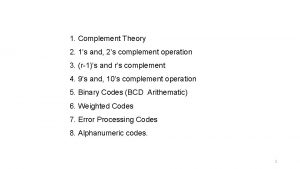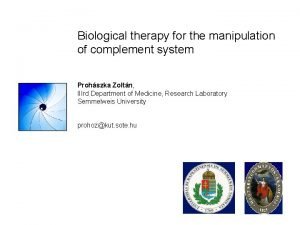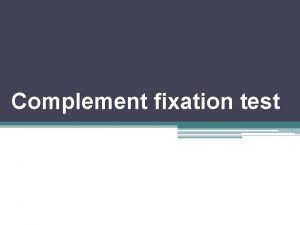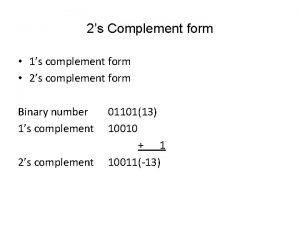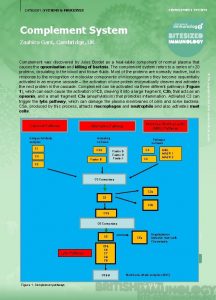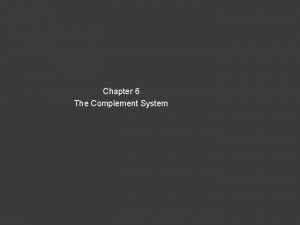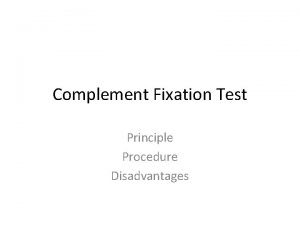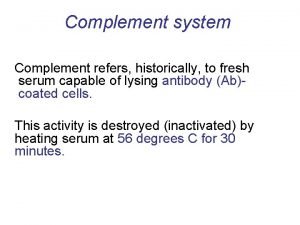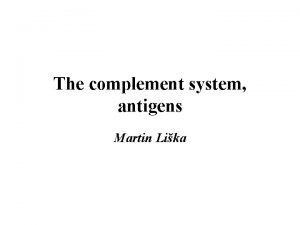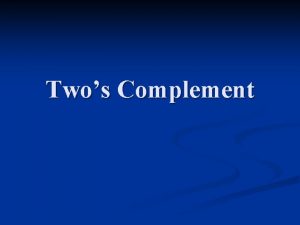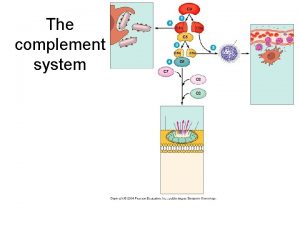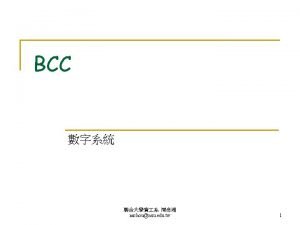The Complement System Introduction n The complement system





















- Slides: 21

The Complement System

Introduction n The complement system consists of a number of small proteins found in the blood, in general synthesized by the liver, and normally circulating as inactive precursors (pro-proteins) n When stimulated ---release cytokines and initiate an amplifying cascade of further cleavages. n The complement system is part of the innate immune response (vs adaptive)

In 1899, Paul Ehrlich named as complement n It is named “complement system” because it was first identified as a heat-labile component of serum that “complemented” antibodies in the killing of bacteria n It is now known that it consists of over 30 proteins and contributes 3 g/L to overall serum protein quantities n



“Classical” Pathway (Specific immune response) n n Begins with antibody binding to a cell surface and ends with the lysis of the cell The proteins in this pathway are named C 1 -C 9 (the order they were discovered and not the order of the reaction) When complement is activated it is split into two parts – a – smaller – B – larger part and usually the active part Remember 3 Key Words – ACTIVATION – AMPLIFICATION – ATTACK

“Classical Pathway” n ACTIVATION – C 1 q portion of C 1 attaches to the Fc portion of an antibody – Only Ig. G and Ig. M can activate complement – Once activated C 1 s is eventually cleaved which activates C 4 and C 2 – C 4 b & C 2 a come together to form the C 4 b 2 a which is the C 3 convertase – C 3 convertase activates C 3 to C 3 a and C 3 b

“Classical Pathway” n ACTIVATION – C 3 a binds to receptors on basophils and mast cells triggering them to release there vasoactive compounds (enhances vasodilation and vasopermeability). – C 3 a is called an anaphylatoxin (a fragment that activate the complement system) – C 3 b serves as an opsonin which facilitates immune complex clearance

“Classical Pathway” n AMPLIFICATION – Each C 1 s creates many C 4 b and C 2 b fragments – Each C 4 b. C 2 a creates many C 3 b (activated C 3) – Each C 3 b goes on to create many Membrane Attack Complexes – Example n 1 C 1 S makes 100 C 4 b. C 2 b n 100 C 4 b. C 2 b makes 10, 000 C 3 b n 10, 000 C 3 b makes 1, 000 MAC

“Classical Pathway” n ATTACK – Most C 3 b serves an opsonin function – Some C 3 b binds to C 4 b. C 2 a to form the C 5 convertase C 4 b. C 2 a. C 3 b – C 5 convertase cleaves C 5 leading to the formation of the Membrane attack Complex (C 5 -C 6 -C 7 -C 8 -C 9) – The MAC (memberane attack cells/Unit) “punches holes” in cell walls resulting in lysis

Co m pl em en t. P at hw ay

“Alternative Pathway” (Non specific immune response) n Properdin (Regulator- complement activation) Pathway n Requires no specific recognition of antigen in order to cause activation

“Alternative Pathway” n ACTIVATION – Spontaneous conversion from C 3 to C 3 b occurs in body – Normally, C 3 b is very short lived and quickly inactivated by proteins on the surface of the body’s own cell walls – However, bacteria or other foreign material may lack these surface proteins allowing C 3 b to bind and stay active

“Alternative Pathway” n AMPLIFICATION – Factor B binds to C 3 b – Factor B is then cleaved by factor D into Ba and Bb – C 3 b. Bb remains which acts as a C 3 convertase (C 3 C 3 a and C 3 b) – C 3 b. Bb. C 3 b is formed which acts as a C 5 convertase

“Alternative Pathway” n ATTACK – C 5 is cleaved to C 5 a and C 5 b – C 5 b then starts the assembly of the Membrane Attack Complex

Alternative Pathway

Lectin pathway Activate mannose-binding lectin n Antibody not involved n The lectin pathway is homologous to the classical pathway but with the opsonin, mannose-binding lectin (MBL), and ficolins, instead of C 1 q n

Lectin pathway n This pathway is activated by binding of MBL to mannose residues on the pathogen surface, which activates the MBL-associated serine proteases, MASP-1, and MASP-2 (very similar to C 1 r and C 1 s, respectively), which can then split C 4 into C 4 a and C 4 b and C 2 into C 2 a and C 2 b. C 4 b and C 2 a then bind together to form the classical C 3 convertase, as in the classical pathway.

Lectin pathway n Ficolins are homologous to MBL and function via MASP in a similar way.

Summary - Activation n Complement can be activated by the binding of antibody (Classical) or by the adherance of C 3 b to foreign material (Alternative) n The two pathways converge at the formation of the C 5 convertase (C 4 b 2 a 3 b or C 3 b. Bb. C 3 b) n The final common pathway is the formation of the membrane attack complex

Summary - Function n Opsonization – C 3 b n Chemotaxis – C 5 a (attracts neutrophils) n Increases vasodilation & permeability (Inflammation) of capillary beds via mast cell and basophil activation – C 3 a & C 5 a (Anaphylatoxins) n Cellular Lysis via the MAC (Membrane attack cells )(by rupturing membranes of foreign cells)
 Venn diagram notes
Venn diagram notes Bcd subtraction using 1's complement
Bcd subtraction using 1's complement Cell lysis complement system
Cell lysis complement system Complement system
Complement system Hát kết hợp bộ gõ cơ thể
Hát kết hợp bộ gõ cơ thể Lp html
Lp html Bổ thể
Bổ thể Tỉ lệ cơ thể trẻ em
Tỉ lệ cơ thể trẻ em Voi kéo gỗ như thế nào
Voi kéo gỗ như thế nào Thang điểm glasgow
Thang điểm glasgow Chúa sống lại
Chúa sống lại Các môn thể thao bắt đầu bằng tiếng bóng
Các môn thể thao bắt đầu bằng tiếng bóng Thế nào là hệ số cao nhất
Thế nào là hệ số cao nhất Các châu lục và đại dương trên thế giới
Các châu lục và đại dương trên thế giới Công thức tính thế năng
Công thức tính thế năng Trời xanh đây là của chúng ta thể thơ
Trời xanh đây là của chúng ta thể thơ Mật thư tọa độ 5x5
Mật thư tọa độ 5x5 Làm thế nào để 102-1=99
Làm thế nào để 102-1=99 Phản ứng thế ankan
Phản ứng thế ankan Các châu lục và đại dương trên thế giới
Các châu lục và đại dương trên thế giới Thể thơ truyền thống
Thể thơ truyền thống Quá trình desamine hóa có thể tạo ra
Quá trình desamine hóa có thể tạo ra

